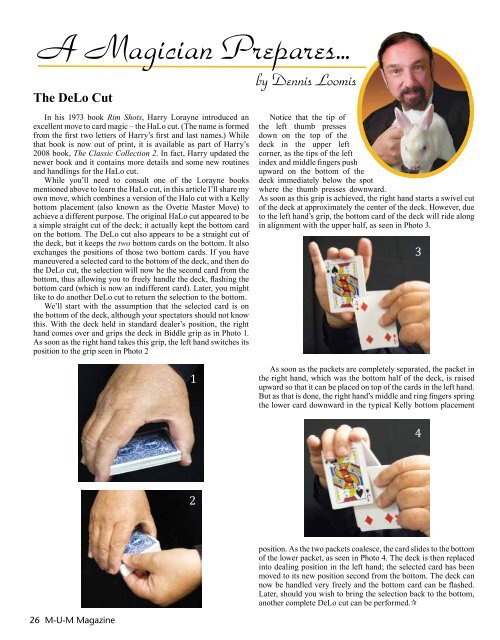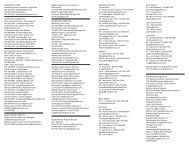(Hank) Moorehouse 1934 – 2011 - The Society of American Magicians
(Hank) Moorehouse 1934 – 2011 - The Society of American Magicians
(Hank) Moorehouse 1934 – 2011 - The Society of American Magicians
You also want an ePaper? Increase the reach of your titles
YUMPU automatically turns print PDFs into web optimized ePapers that Google loves.
A Magician Prepares...<br />
the delo Cut<br />
In his 1973 book Rim Shots, Harry Lorayne introduced an<br />
excellent move to card magic <strong>–</strong> the HaLo cut. (<strong>The</strong> name is formed<br />
from the first two letters <strong>of</strong> Harry’s first and last names.) While<br />
that book is now out <strong>of</strong> print, it is available as part <strong>of</strong> Harry’s<br />
2008 book, <strong>The</strong> Classic Collection 2. In fact, Harry updated the<br />
newer book and it contains more details and some new routines<br />
and handlings for the HaLo cut.<br />
While you’ll need to consult one <strong>of</strong> the Lorayne books<br />
mentioned above to learn the HaLo cut, in this article I’ll share my<br />
own move, which combines a version <strong>of</strong> the Halo cut with a Kelly<br />
bottom placement (also known as the Ovette Master Move) to<br />
achieve a different purpose. <strong>The</strong> original HaLo cut appeared to be<br />
a simple straight cut <strong>of</strong> the deck; it actually kept the bottom card<br />
on the bottom. <strong>The</strong> DeLo cut also appears to be a straight cut <strong>of</strong><br />
the deck, but it keeps the two bottom cards on the bottom. It also<br />
exchanges the positions <strong>of</strong> those two bottom cards. If you have<br />
maneuvered a selected card to the bottom <strong>of</strong> the deck, and then do<br />
the DeLo cut, the selection will now be the second card from the<br />
bottom, thus allowing you to freely handle the deck, flashing the<br />
bottom card (which is now an indifferent card). Later, you might<br />
like to do another DeLo cut to return the selection to the bottom.<br />
We’ll start with the assumption that the selected card is on<br />
the bottom <strong>of</strong> the deck, although your spectators should not know<br />
this. With the deck held in standard dealer’s position, the right<br />
hand comes over and grips the deck in Biddle grip as in Photo 1.<br />
As soon as the right hand takes this grip, the left hand switches its<br />
position to the grip seen in Photo 2<br />
26 M-U-M Magazine<br />
1<br />
2<br />
by Dennis Loomis<br />
Notice that the tip <strong>of</strong><br />
the left thumb presses<br />
down on the top <strong>of</strong> the<br />
deck in the upper left<br />
corner, as the tips <strong>of</strong> the left<br />
index and middle fingers push<br />
upward on the bottom <strong>of</strong> the<br />
deck immediately below the spot<br />
where the thumb presses downward.<br />
As soon as this grip is achieved, the right hand starts a swivel cut<br />
<strong>of</strong> the deck at approximately the center <strong>of</strong> the deck. However, due<br />
to the left hand’s grip, the bottom card <strong>of</strong> the deck will ride along<br />
in alignment with the upper half, as seen in Photo 3.<br />
As soon as the packets are completely separated, the packet in<br />
the right hand, which was the bottom half <strong>of</strong> the deck, is raised<br />
upward so that it can be placed on top <strong>of</strong> the cards in the left hand.<br />
But as that is done, the right hand’s middle and ring fingers spring<br />
the lower card downward in the typical Kelly bottom placement<br />
position. As the two packets coalesce, the card slides to the bottom<br />
<strong>of</strong> the lower packet, as seen in Photo 4. <strong>The</strong> deck is then replaced<br />
into dealing position in the left hand; the selected card has been<br />
moved to its new position second from the bottom. <strong>The</strong> deck can<br />
now be handled very freely and the bottom card can be flashed.<br />
Later, should you wish to bring the selection back to the bottom,<br />
another complete DeLo cut can be performed.�<br />
3<br />
4



